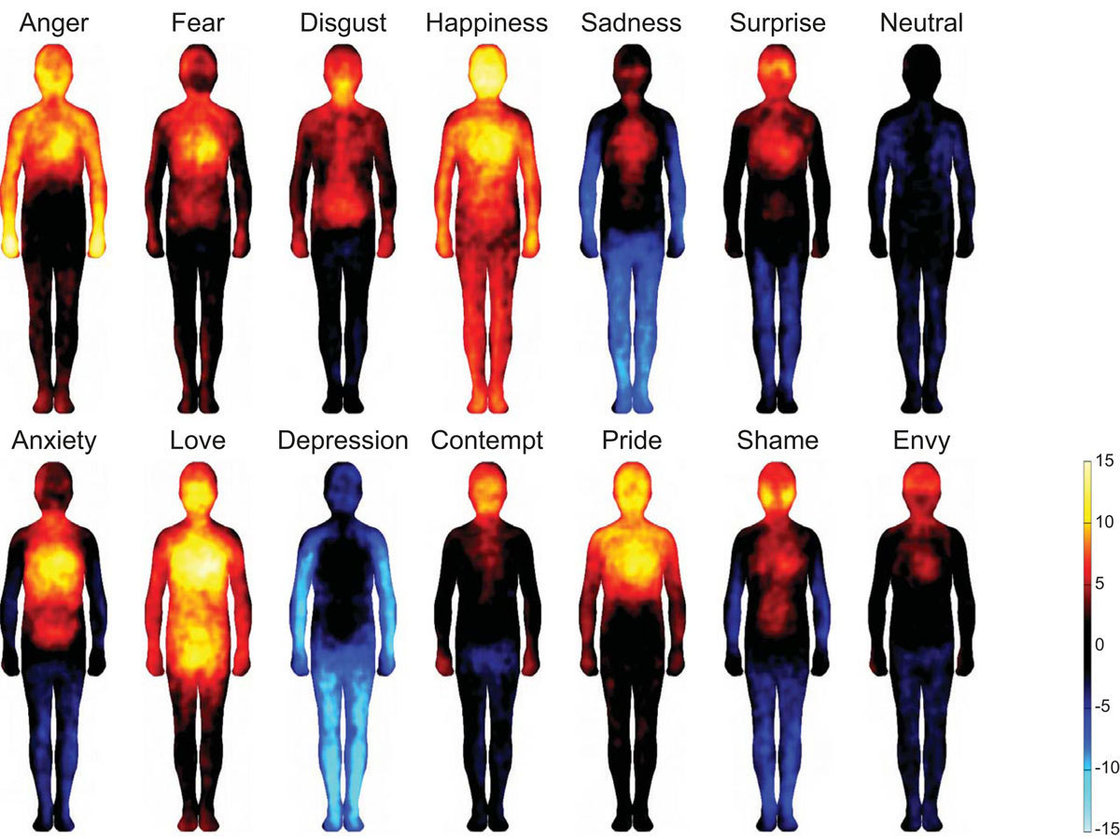HJ: Have you ever noticed that you feel specific emotions in different parts of your body? A team of Finnish researchers has created an innovative visual map that shows how different ares of our body are stimulated by different emotions, adding further proof to the growing realization that there is a very real, direct link between the body and the mind. So much so that scientists are now able to measure the level of impact that provoked emotional responses have on specific areas of the body. These findings could have major implications for understanding and diagnosing disease states and also creating therapies and treatments to heal them. Furthermore, for individuals interested in exploring the connection between the mind and body, this incredibly detailed visualization will likely provide many insights into the complex relationship between the two.
– Truth
Fascinating New Study Shows How Emotions Are Mapped On The Human Body
By Michael Forrester | Prevent Disease
—
Emotions coordinate our behavior and physiological states during survival-salient events and pleasurable interactions. Even though we are often consciously aware of our current emotional state, such as anger or happiness, the mechanisms giving rise to these subjective sensations have remained unresolved. Brilliant research by Finnish scientists has mapped the areas of our body that are experiencing an increase or decrease in sensory activity when we experience a particular emotion.
(Click for Larger Image) Image courtesy of Lauri Nummenmaa, Enrico Glerean, Riitta Hari, and Jari Hietanen.
Depending on whether we are happy, sad or angry, we have physiological sensations that are not located in different areas of the body. We overlook this reality from one day to the next (the famous “lump in the breast” generated by anxiety, the feeling of warmth that pervades our face and our cheeks particularly when we feel the shame…), and do not consciously realize how much the location of these body areas activated by our emotions and how they vary considerably depending on the nature of the emotion.
Researchers around the world are slowly integrating research on how our energetic and emotional states cause health and/or disease. How we connect emotionally to our overall wellness and wellbeing may indeed be more relevant than any supplement, food, exercise, medical intervention or health treatment.
Finnish scientists have for the first time mapped areas of the body activated according to each emotion (happiness, sadness, anger, etc).This map was compiled following a study of 700 Finnish, Swedish and Taiwanese volunteers.
They used a topographical self-report tool to reveal that different emotional states are associated with topographically distinct and culturally universal bodily sensations; these sensations could underlie conscious emotional experiences. Monitoring the topography of emotion-triggered bodily sensations brings forth a unique tool for emotion research and could even provide a biomarker for emotional disorders.
Participants were first asked to watch video sequences associated with different emotions and identify parts of their body where they felt an increase or decrease of bodily sensations.
Emotions are often felt in the body, and somatosensory feedback has been proposed to trigger conscious emotional experiences. The resulting map shows that each type of emotion activates a network of specific areas of the body, distinct from those activated by other types of emotions.
Every type of emotion carries a specific unique energy and a different vibrational frequency. All organs, tissues, membranes, glands, cells, vibrate in precise frequencies in the human body and they are all influenced by our emotions.
Different emotions were consistently associated with statistically separable bodily sensation maps across experiments. These maps were concordant across West European and East Asian samples. Statistical classifiers distinguished emotion-specific activation maps accurately, confirming independence of topographies across emotions.
The body map shows emotions such as anger are mainly active in the chest, the lower part of the face and arms, with particular intensity on the hands. On disgust, it activates the body areas which are mainly concentrated around the mouth and throat. As for love, three areas are concerned, the face, chest and lower abdomen. Finally, happiness is probably the most significant emotion that solicits our enitre body to respond, as the study shows that it generates bodily sensations in all areas, especially on the face and chest.
The body map identifies areas in which the people experienced increased sensory activity when emotion is felt, but also lists the areas that are home to a decrease in sensory activity. Thus, we learn that the emotions associated with depression have the effect of generating a feeling of decline in sensory activity in the arms and legs.
The results obtained by the research show a remarkable consistency in results, suggesting that the mechanisms underlying bodily sensations that we perceive when we experience a particular emotion are likely dictated by energetic patterns and biology rather than culture.
The researchers proposed that emotions represented in the somatosensory system are culturally universal categorical somatotopic maps. Perception of these emotion-triggered bodily changes may play a key role in generating consciously felt emotions.
This work was published December 31, 2013 in the journal Proceedings of The National Academy of Sciences under the title “Bodily maps of emotions”.














Orlagh OBrien
January 27, 2014
Interesting to note another project, which I completed 7 years ago is along similar lines – while completing a graphic design research MA at London College of Communication. It’s amazing how the humanities and science can overlap.www.emotionallyvague.com/results_02.php Conference presentation: http://www.youtube.com/watch?v=yBAF5MAjI1A.